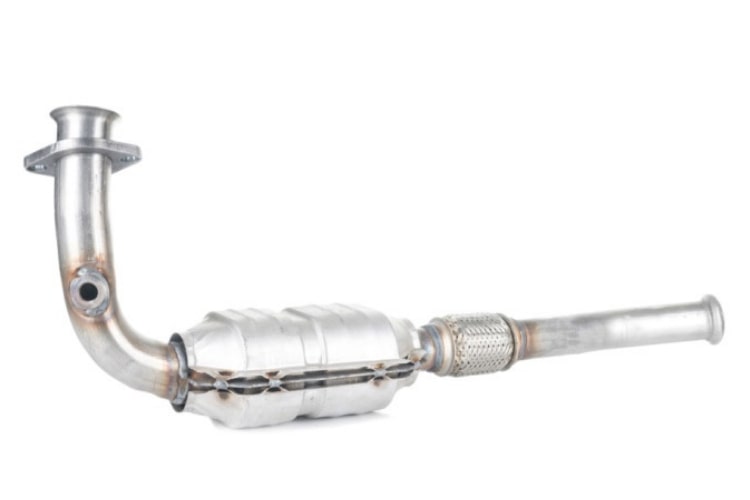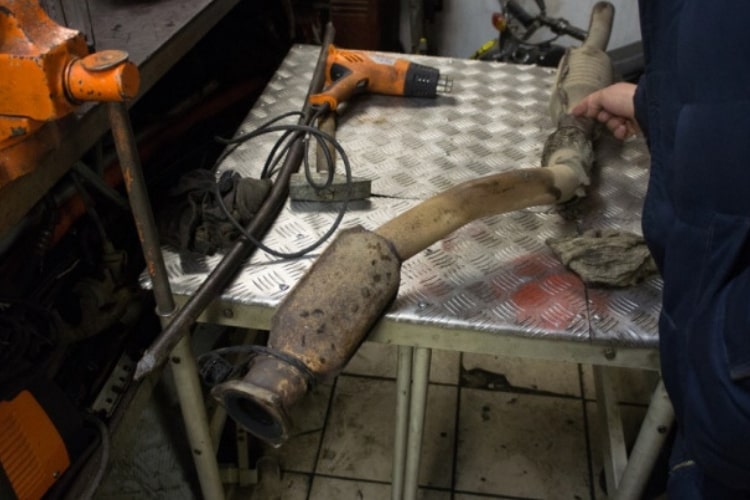Symptoms of a Bad Catalytic Converter
Your vehicle’s catalytic converter serves an important role: it transforms chemicals created during the combustion process from hazardous to harmless, thus reducing air pollution. It achieves this remarkable feat thanks to a honeycomb mesh that is coated with a catalyst. Through a chemical reaction, this catalysts converts the chemical makeup of the emissions. While catalytic converters are designed to last for the lifetime of a vehicle that doesn’t always happen.

Over time, residue from the exhaust gases a cat is rendering harmless build up within its honeycomb-shaped interior. Sometimes, so much residue builds up that the catalytic converter clogs and stops working. If this integral part fails, your vehicle will spew hazardous emissions into the environment and you may not even know it — until your vehicle fails its next inspection.
- Your vehicle’s check-engine light is onOpens a new window, and you’re not sure why. When your check-engine light illuminates, “catalytic converter problem” is probably not your first suspicion. If you rule out other causes of an engine-misfire, oxygen sensor, or emissions-related code, have a repair technician check your cat.
- You smell rotten eggs. Fuel contains sulfates, which are characterized by that stinky rotten egg smell. A clogged cat causes fuel to build up, making the usually undetectable odor noticeable.
- The exhaust smoke coming out of your car’s tailpipe is dark. A clogged cat makes it more difficult for exhaust to exit your vehicle, so it builds up and is thicker and darker when it comes out.

- Your vehicle’s gas mileage has decreased noticeably. Experiencing pain at the pump? That, combined with other symptoms, could point to a catalytic converter failure. A clogged cat causes reduced airflow that causes your engine to burn extra fuel. Not only does this increase your fuel bill and waste gas, it makes the clog worse. To the average driver, lower fuel efficiency is one of the most noticeable symptoms of a bad catalytic converter.
- Your vehicle is misfiringOpens a new window. Catalytic converter problems cause gas within your engine to heat up to the point that it actually ignites. This ignition is what causes the misfiring sensation – and that can destroy engine components. Anytime your vehicle misfires, you should have it checked out by a reputable service professional.
- You remove oxygen sensors and vehicle performance plummets. If you happen to know your way around under the hood (or better yet you know a great mechanic) you can run a test. Remove your car’s oxygen sensors from the exhaust system (temporarily). If performance worsens noticeably, that’s a sure sign your catalytic converter is going bad.
- You hear a rattling sound coming from beneath your vehicle. A rattling sound coming from your car is never a good sign. When a catalytic converter becomes damaged, it can cause the honeycomb mesh interior to break or collapse. When you turn on your vehicle, these pieces will vibrate and make a rattling sound.
An Ounce of Prevention…
Unfortunately, if you discover your catalytic converter has failed it cannot be repaired and must be replaced. Replace it sooner rather than later to avoid contributing to air pollution, and to avoid potential collateral damage to your engine and exhaust system. Replacing a catalytic converter isn’t cheap. By one estimate, most replacements will cost between $1,300 and $1,600. A better option? Be diligent about preventive maintenance. Keep your exhaust system clean and well-maintained so you can avoid catalytic converter problems in the first place.






I appreciate the information given in this article regarding the importance of the catalytic converter in the performance of the vehicle. Internal combustion chamber emits a huge amount of carbon monoxide and unburned hydrocarbons which are toxic chemicals. The catalytic converter converts the carbon monoxide into carbon dioxide and water and hence reduces the quantity of the toxic chemicals. However, malfunctions in the catalytic converter could jeopardize the effectiveness of the emission control system of the vehicle which has significant negative impacts. So, signs which indicate that the catalytic converter has some sort of mechanical deformities should not be ignored and the mechanical complications associated with the catalytic converter or other components of the emission control system should be identified and repaired immediately. For more information, visit https://entirelyxmotors.com/reasons-behind-the-failure-of-your-vws-emission-control-system-from-the-experts-in-glendale/
And one mishap of bad fuel in your vehicle cause your Cadillac converter to be bad all at once
My truck is making a rattling sound. I have been told it is the catalytic converter……Is there any way i can repair it. My truck is not slugglish. It runs good. The rattling sound starts from the time i start the truck and until i cut it off.
Did my catalytic converter is clogged and I remove the O2 sensor it should run better shouldn’t it you say it should run worse